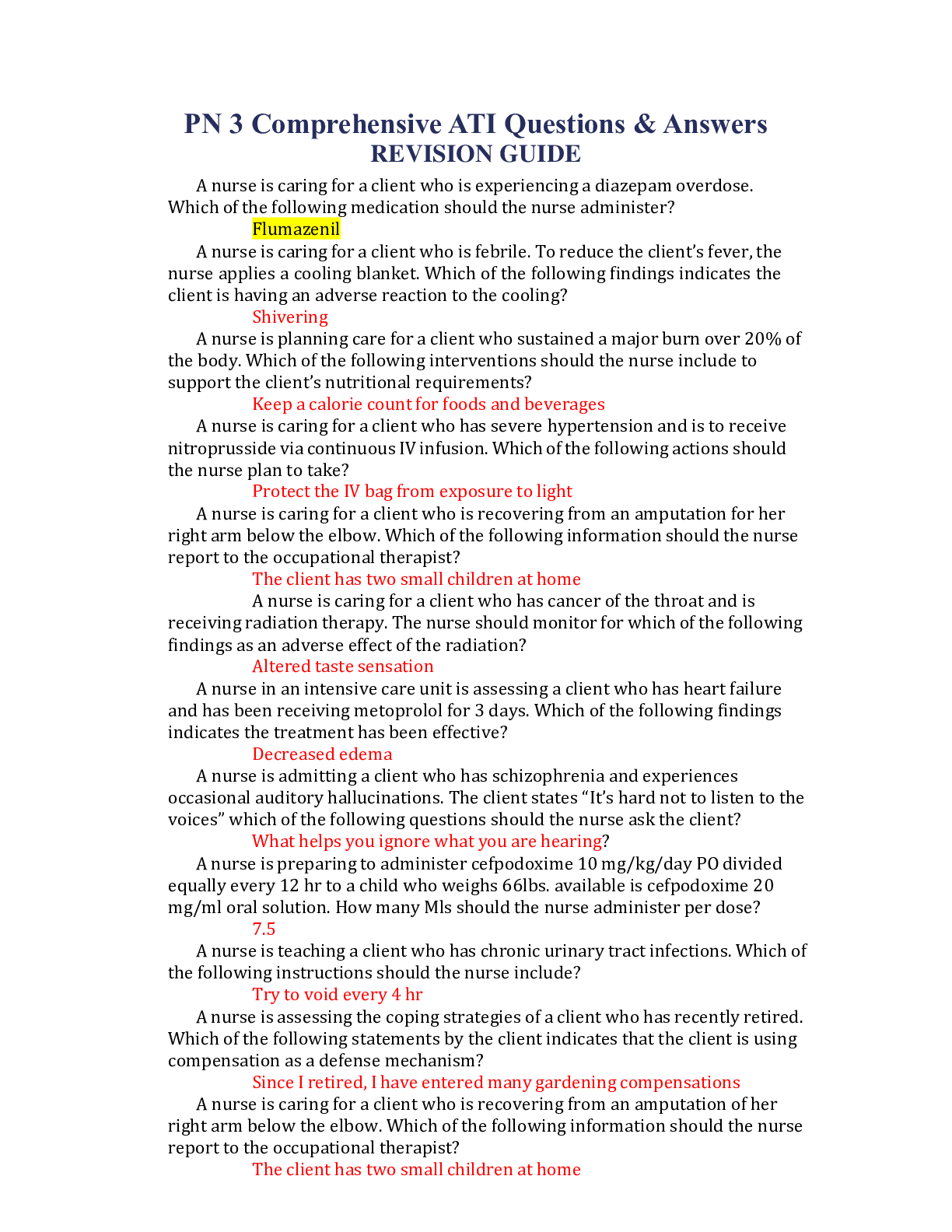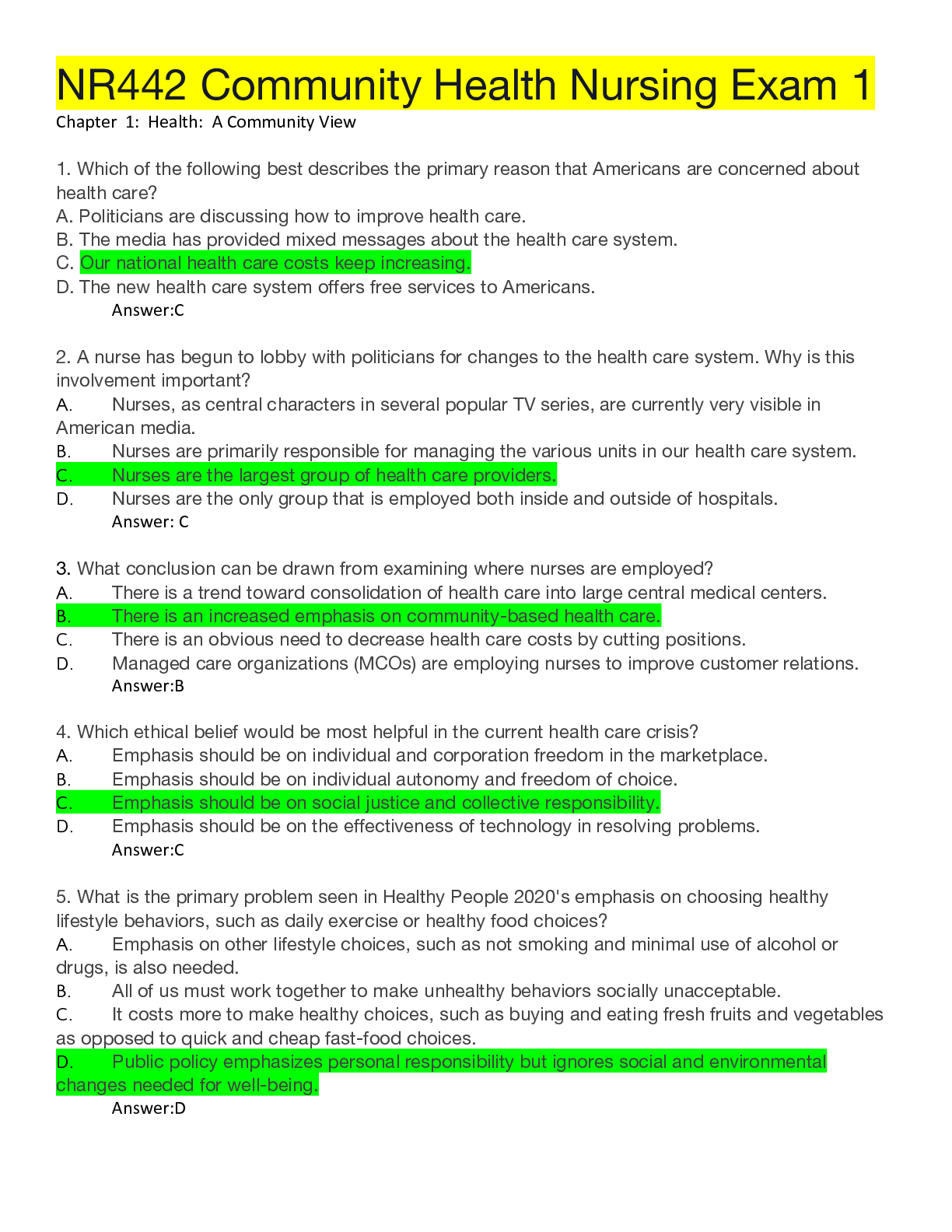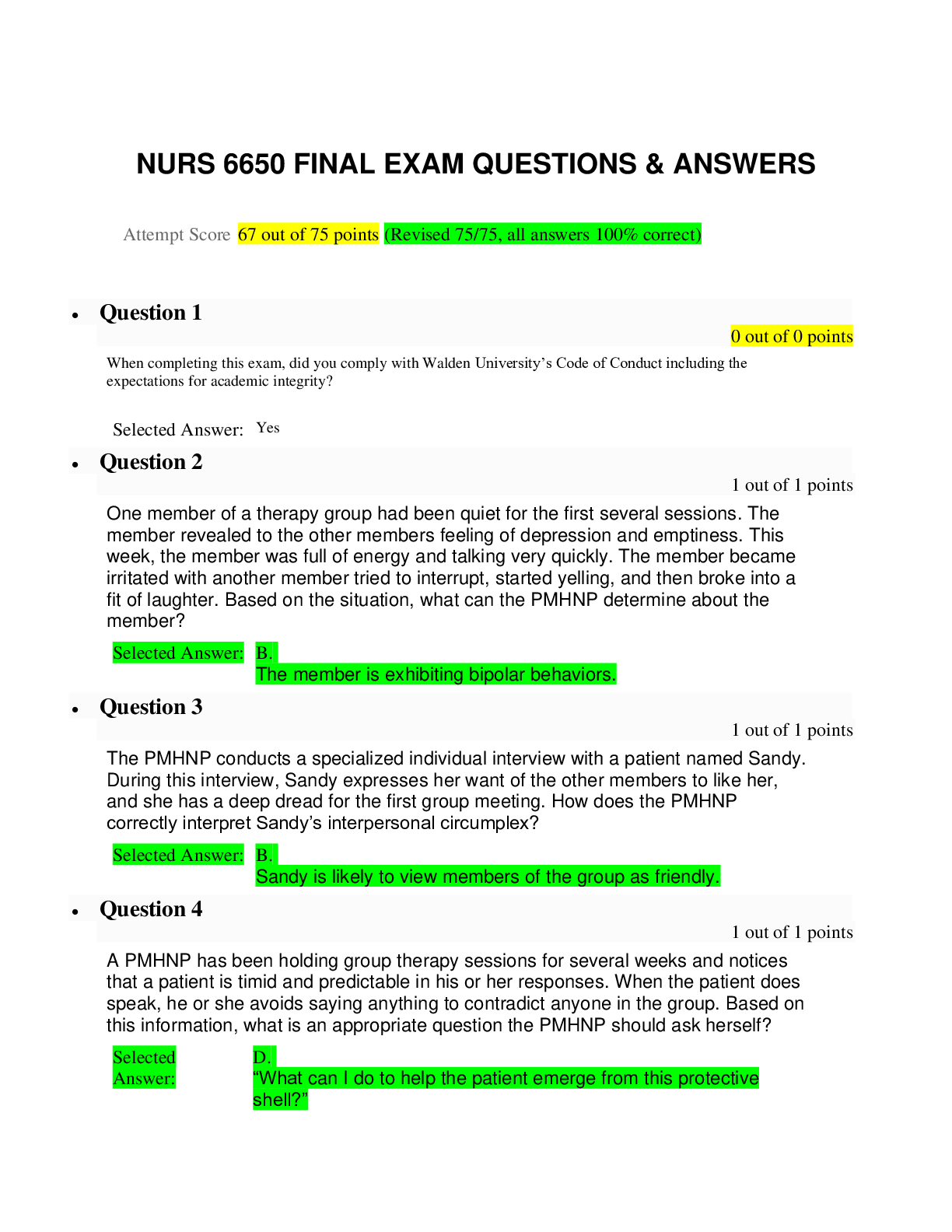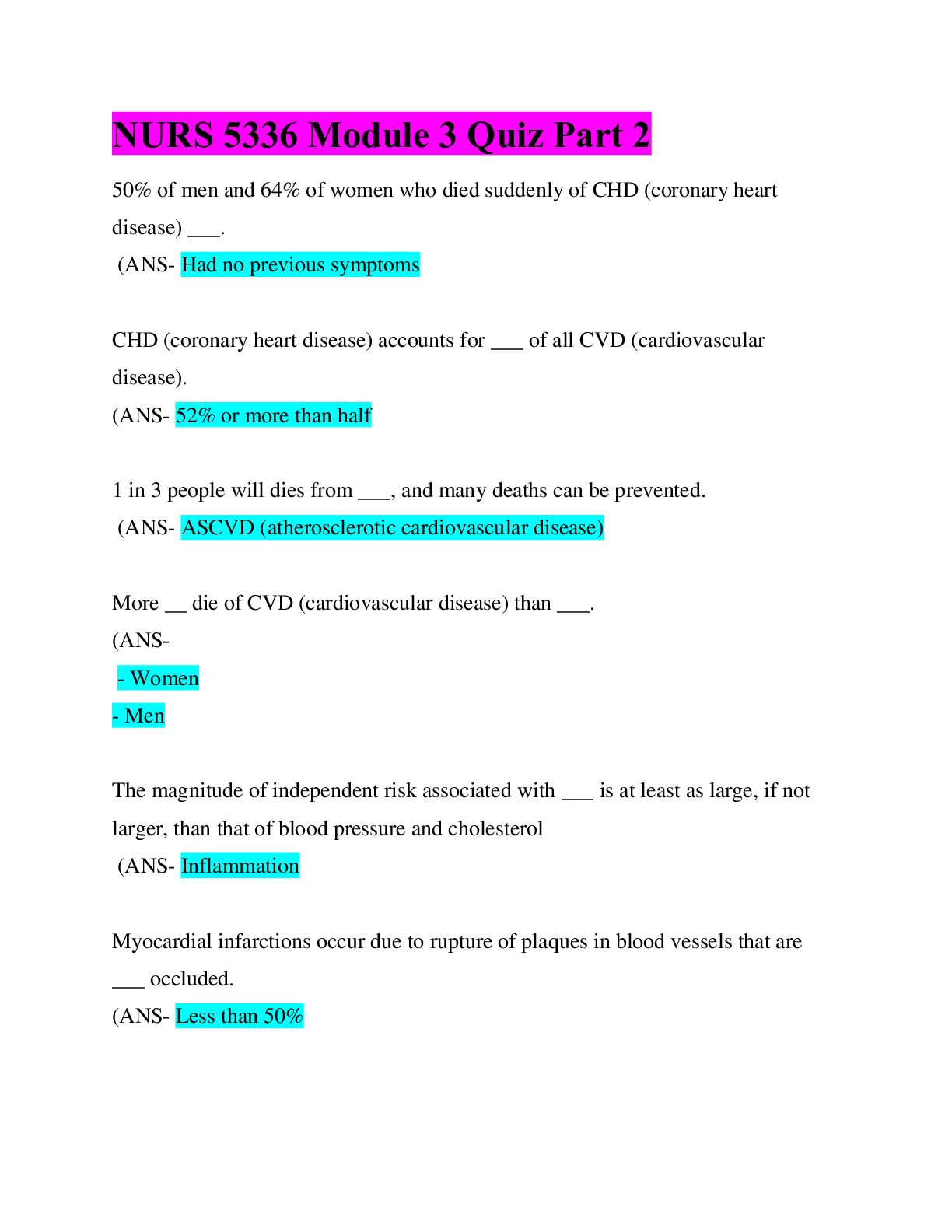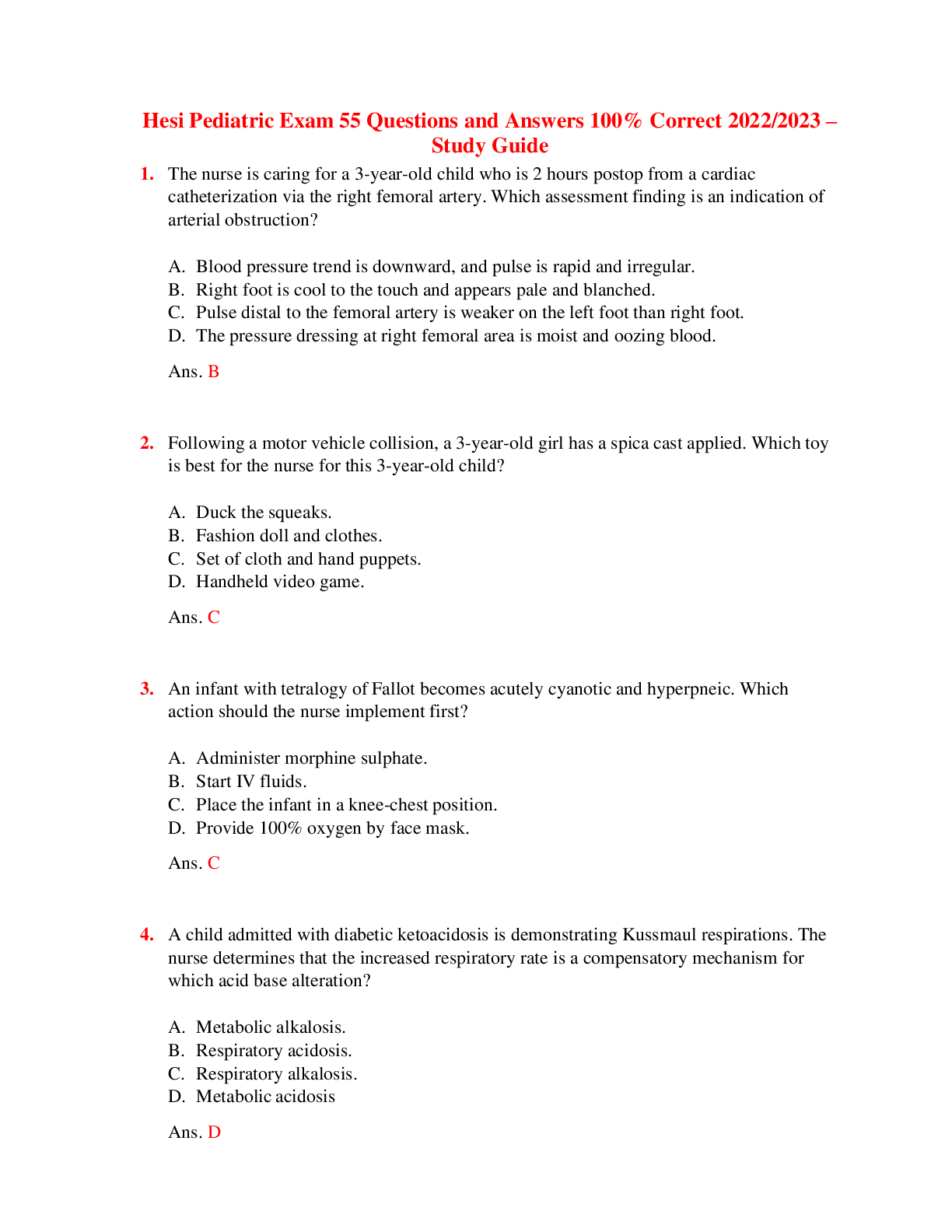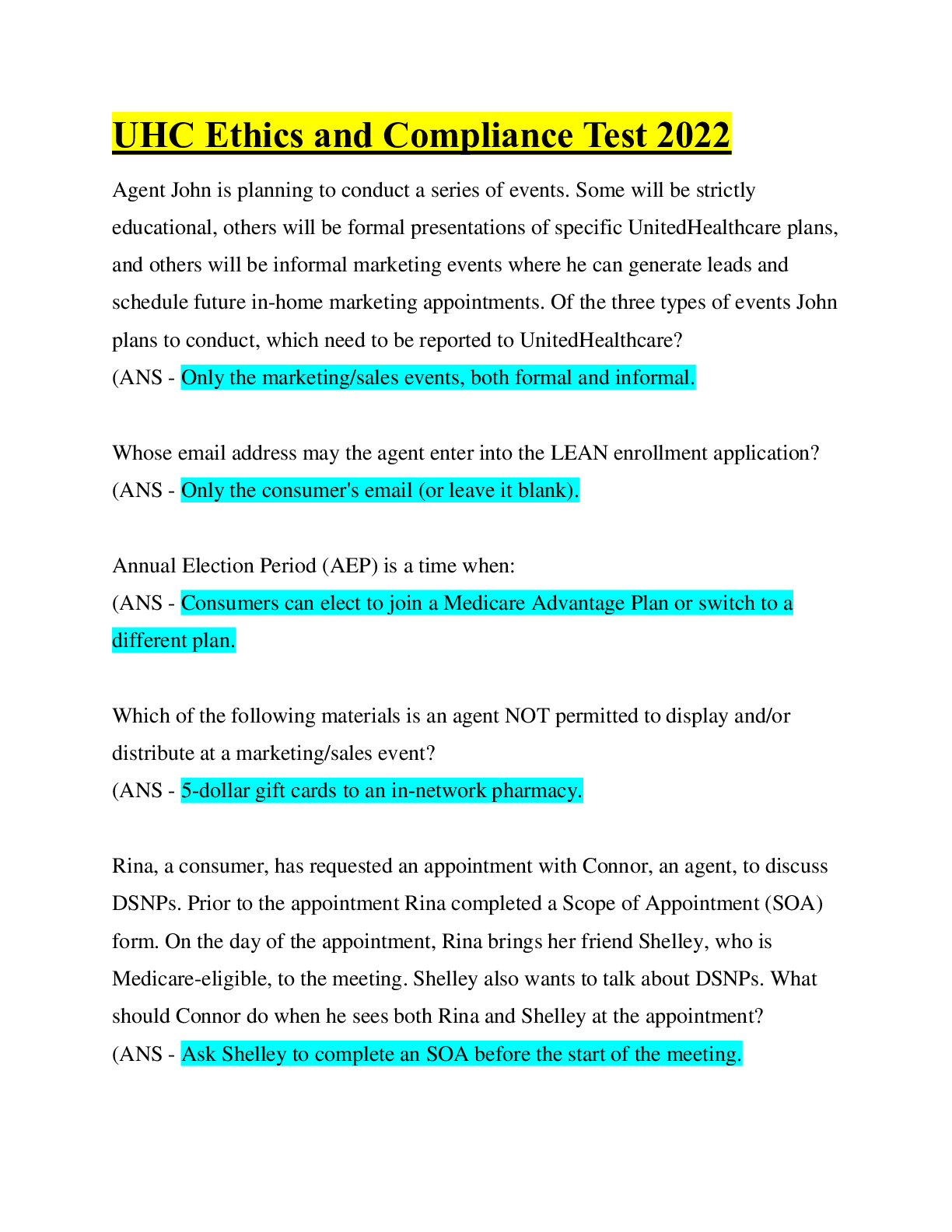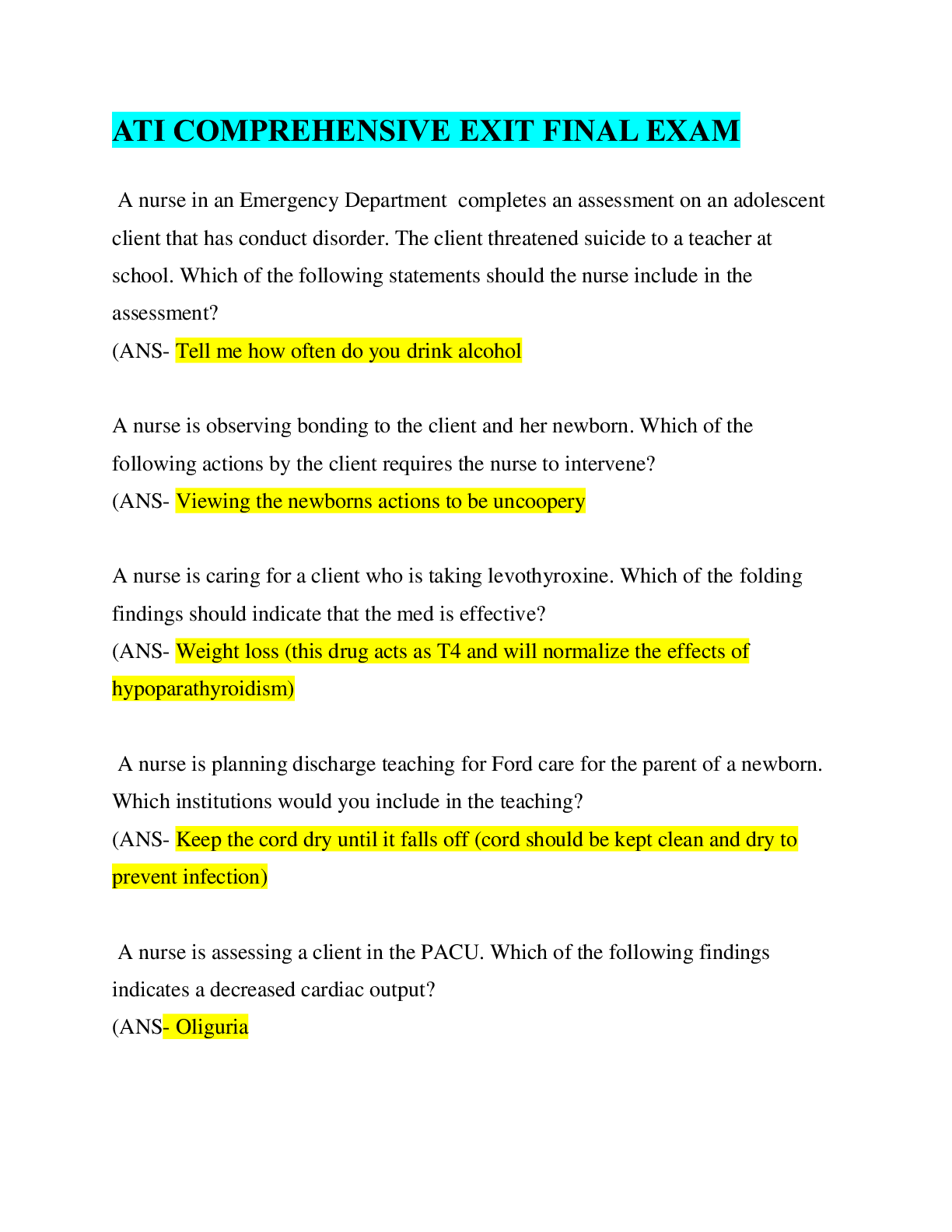Health Care > EXAM > ATI MEDSURG PROCTORED EXAM ( questions & answers 2022) (All)
ATI MEDSURG PROCTORED EXAM ( questions & answers 2022)
Document Content and Description Below
1.A nurse is assessing a client who is 12hr postoperative following a colon resection. Which of the following findings should the nurse report to the surgeon? 1. Heart rate 90/min 2. Absent bowel s... ounds → normal findings after major bowel surgery; takes several days to return to normal. 3. Hgb 8.2 g/dl 4. Gastric pH of 3.0 Rationale: Normal Hgb is 13-18M g/dl, 12-16 g/dl. This may indicate a possible hemorrhaging. 2. A nurse is caring for a client who has diabetes insipidus. Which of the following medications should the nurse plan to administer? a. Desmopressin b. Regular insulin c. Furosemide d. Lithium carbonate Rationale: Diabetes Insipidus has decreased ADH. Administer Desmopressin/Vasopressin increase ADH and keeps pt. on urinating 3. A nurse is admitting a client who has arthritic pain and reports taking ibuprofen several times daily for 3 years. Which of the following test should the nurse monitor? a. Fasting blood glucose b. Stool for occult blood c. Urine for white blood cells d. Serum calcium Rationale:ATI Pharm 16. Pg. 485 Ibuprofen (NSAIDs) monitor for GI bleed (bloody, tarry stools, abd pain). 4. A nurse in the emergency department is assessing a client. Which of the following actions should the nurse take first (Click on the “Exhibit” button for additional information about the client. There are three tabs that contain separate categories of data.) a. Obtain a sputum sample for culture b. Prepare the client for a chest x-ray c. Initiate airborne precautions d. Administer ondansertron. Rationale: No idea what the Exhibit is all about; wont be able to answer it. 5. A nurse is contacting the provider for a client who has cancer and is experiencing breakthrough pain. Which of the following prescriptions should the nurse anticipate? a. Transmucosal fentanyl b. Intramuscular meperidine c. Oral acetaminophen d. Intravenous dexamethasone Rationale:ATI pg. 27 6. A nurse is admitting a client who reports chest pain and has been placed on a telemetry monitor. Which of the following should the nurse analyze to determine whether the client is experiencing a myocardial infarction? a. PR interval b. QRS duration c. T wave d. ST segment Rationale: ST elevation indicates MI. ST depression indicates ischemia 7. A nurse is teaching a client who has ovarian cancer about skin care following radiation treatment. Which of the following instructions should the nurse include? a. Pat the skin on the radiation site to dry it ATI MEDSURG PROCTORED EXAM b. Apply OTC moisturizer to the radiation site c. Cover the radiation site loosely with a gauze wrap before dressing d. Use a soft washcloth to clean the area around the radiation site Rationale: pg. 584. Dry the area thoroughly using patting motions. 8. A nurse is caring for a client who is receiving a blood transfusion. The nurse observes that the client has bounding peripheral pulses, hypertension, and distended jugular veins. The nurse should anticipate administering which of the following prescribed medications? a. Diphenhydramine b. Acetaminophen c. Pantoprazole d. Furosemide Rationale: S/S may indicate fluid retention or heart failure. It is important to administer diuretics to prevent cardiovascular/respiratory distress. 9. A nurse is assessing a client who is receiving magnesium sulfate IV for the treatment of hypomagnesemia. Which of the following findings indicates effectiveness of the medication? a. Lungs clear b. Apical pulse 82/min c. Hyperactive bowel sounds d. Blood pressure 90/50 mm Hg Rationale: ATI p. 494: s/s of hypomagnesemia consist of hypoactive bowel sounds, constipation, paralytic ileus. So effectiveness would indicate opposite of this 10. A nurse is reviewing a client’s ABG results pH 7.42, PaC02 30 mm Hg, and HCO3 21 mEq/L. The nurse should recognize these findings as indication of which of the following conditions? a. Metabolic acidosis b. Metabolic alkalosis c. Compensated respiratory alkalosis d. Uncompensated respiratory acidosis Rationale: because the HCO3 21 trying to compensate for respiratory alkalosis 11. A nurse is caring for a client who has a deep partial thickness burns over 15% of her body which of the following labs should the nurse expect during the first 24 hours A. Decreased BUN ELEVATED DT fluid loss B. Hypoglycemia (High due to stress) C. Hypoalbuminemia (Low due to fluid loss) D. Decreased Hematocrit (Elevated due to 3rd spacing during resuscitation phase) (Page 481 ch 75 med surge ati pdf 10.0) 12. A nurse is caring for a client who has dumping syndrome following a gastrectomy, which of the following actions should the nurse take ? a. Offer the client high carbohydrate meal options (High fat, high protein, low fiber, low to moderate carbs page 317, chapter 49 Peptic ulcer disease med surge ati pdf 10.0) b. Provide the client with four full meals a day (Small frequent meals) c. Encourage the client to to drink at least 360 ml of fluids with meals (Eliminate liquids with meals for 1 hr prior and following a meal) d. Have the client lie down for 30 minutes after meals (Lying down after a meal slows the movement of food within the intestines) 13. A nurse is teaching a group of young adult clients about risk factors for hearing loss. Which of the following factors should the nurse include in the teaching? SATA. (p.70 chapter 13) Born with a high weight Chronic infections of the middle ear Use a loop diuretic Perforation of the ear drum ATI MEDSURG PROCTORED EXAM Frequent exposure to low volume noise 14. A nurse is preparing to administer fresh frozen plasma to a client . Which of the following actions should the nurse take? (Chapter 92 page 606 med surge ati pdf 10.0) Administer the plasma immediately after thawing (Blood must be warm, you also have a 30 minute window to give it so bacteria doesn’t grow. So it doesn’t necessarily have to be right away.) Transfuse the plasma over 4 hour (Can be in 2 to 4 hours) Hold the transfusion if the client is actively bleeding (YOU HAVE TO GIVE IT. That’s the whole point! The patient is losing blood so you have to replace it. We give fresh frozen plasma because he or she may have clotting deficiencies) Administer the transfusion through a 24 gauge saline lock (Has to be a 18 or 20 gauge) 15. A nurse is assessing a clients who reports numbness and tingling of his toes and exhibits a positive TROUSSEAU. Which of the following electrolyte imbalance should the nurse suspect? (ch 44 page 277 MS ATI PDF 10.0) Hypoatremia Hyperchloremia Hypermagnesemia Hypocalcemia (low calcium = low ca causes increased firing = spasms. Learned this is LVN school.) 16. A home health nurse is teaching a clients how to care for a peripherally central catheter in his right arm. Which of the following statements should the nurse include in the teaching? (Chapter 27 cardiovascular diagnostics and therapeutic procedures p. 165 MS ATI PDF 10.0) Change the transparent dressing over the insertion site every 48 hours - transparent dressing can be up to 7 days Clean the insertion site with mild soap and water - when showering, must insertion site must be covered !!!!! No water can be in it . Measure your right arm circumference once weekly- does not say in the chapter Use a 10 milliliter syringe when flushing the catheter - flush with 10 ml NS b4 and after med administration 17. A nurse is caring for a client who has a central venous access device. Which of the following assessment findings should the nurse report to the provider? (P.166 MS ATI PDF 10.0) RBC count of 4.7 million/mm 3 BUN 22 mg/ dl - not dramatically high enough to pay attention to. WBC count of 16,000/ mm 3 - phlebitis is a complication , infection is a complication that can happen 7 days after insertion , also temp increase if 1 degree can happen. Blood glucose of 120 mg/dl 18. A nurse is providing dietary teaching to a client who has chronic kidney disease and a decreased glomerular filtration rate. Which of the following statements by the client indicates an understanding of the teaching? (p.382 chapter 59) I will spread my protein allowances over the entire day - the doctor issue the patient an allowed amount of protein so its ok. I should increase my intake of canned salmon to three times per week (NO SODIUM) I will season my food with lemon pepper rather than salt (We do not want to give the dietary sodium, potassium, phosphorus , and magnesium. I don’t know what lemon pepper has, but we want to RESTRICT sodium, potassium, phosphorus and magnesium.) I should limit my intake of hard cheese to 3 ounces each day (NO SODIUM at all) 19. A nurse is caring for a client who has a peripherally inserted central catheter. The client is receiving an antibiotic via intermittent IV bolus. Which of the following actions should the nurse take? (PAGE 166 ch 27 MS ATI PDF 10.0) ATI MEDSURG PROCTORED EXAM Administer 20 ml of 0.9 sodium chloride after each dose of medication (you only flush with 10 ml of NS, not 20. 20 is for flushing blood) Flush the catheter using a 5 ml syringe - you use a 10mL syringe to flush Verify the placement with an x ray prior to the initial dose Change the transparent membranes dressing daily (dressing can last for up to 7 days) 20. A nurse is teaching a client using a metered dose rescue inhaler. Which of the following statements should the nurse include in the teaching? Do not shake your inhaler before use (suppose to shake it) Exhale fully before bringing the inhaler to your lips Depress the canister after you inhale (depress the canister before inhaling, and 5 seconds later you inhale) Use peroxide to clean the mouthpiece if your inhaler (warm water) Textbook pg 573. 21. A nurse is assessing the pain status of a group of clients. Which of the following findings indicate a client is experiencing referred pain? (page 30) A client who has angina reports substernal chest pain A client who has pancreatitis reports pain in the left shoulder - referred pain is pain that is felt in ANOTHER PLACE THAT IS NOT IN THE SAME AREAAS WHERE THE PAIN SHOULD BE FELT. THE PAIN IS FELT SOMEWHERE ELSE A client who is postoperative reports incisional pain A client who has peritonitis reports generalized abdominal pain 22. A nurse is caring for a client who has just returned from surgery with an external fixator to the left tibia. Which of the following assessments findings requires immediate intervention by the nurse? (p .456 MS ATI PDF 10.0 chapter 71) The client reports a pain level of 7 on a scale from 0 -10 at the operative site. (This foo just came from surgery so pain is normal for post op patients for first couple of hours.) The clients capillary refill in the left toe is 6 seconds sxs of compartment syndrome. ABCs are compromised. (Cap refill should be below 3 seconds. This is sxs for compartment syndrome. Untreated can lead to necrosis.) The client has an oral temperature of 38.3 (100.9 F) (I wouldn’t pick this because i always see temp 101 as a priority from previous rationales with other atis.) The client has 100 ml of blood in the closed suction drained. (I believe this is normal for post-op patients.) 23. A nurse is assessing a client who has acute pancreatitis and has been receiving total parenteral nutrition for the past 72 hours. Which of the following findings requires the nurse to intervene? (chapter 47 page 299 MS ATI PDF 10.0) Right upper quadrant pain (Dude has acute pancreatitis, so it’s normal) Capillary blood glucose level of 164 mg/dl - glucose not significantly high WBC count 13,000/mm3 (Infection is one complication of TPN administration but WBC is in normal range.) Crackle in bilateral lower lobes (ABC’s compromised, also one of the complications of TPN is fluid imbalance aka fluid volume excess.) 17. A nurse is caring for a client who has hypotension, cool and clammy skin, tachycardia, and tachypnea. In which of the following positions should the nurse place the client? (THIS IS CARDIOGENIC SHOCK!!!!!! P 195. Chapter 31 MS ATI PDF 10.0) Reverse Trendelenburg (page 232 says for hypotension patients must be flat with legs elevated to increase venous return.) Side Lying High Fowlers Feet elevated 20) A nurse is caring for a client who has tuberculosis and is taking rifampin. The client reports that her saliva has turned red-orange in color. Which of the following responses should the nurse make? ATI MEDSURG PROCTORED EXAM a.) “This finding may indicate possible medication toxicity” b.) “Your provider will prescribe a different medication regimen” c.) “This is an expected adverse effect of this medication” PAGE 137 ati MS pdf 10.0 d.) “You will need to increase your fluid intake to resolve this problem” 21) A nurse is preparing to administer a unit of packed RBCs for a client who is receiving a continuous IV infusion of 5% dextrose in water. Which of the following actions should the nurse take? a.) Administer the unit through secondary IV tubing b.) Verify the blood product with an assistive personnel c.) Begin an IV infusion of 0.9% sodium chloride d.) Insert another 22-gauge IV catheter ATI page 249. 22) A nurse is planning care for a client who is 12 hr postoperative following a kidney transplant. Which of the following actions should the nurse include in the plan of care? a.) Check the client’s blood pressure every 8 hr b.) Administer opioids PO c.) Assess urine output hourly d.) Monitor for hypokalemia as a manifestation of acute rejection ATI page 374 23) A nurse in an emergency department is assessing a client who has cirrhosis of the liver. Which of the following is a priority finding? a.) Yellow sclera (Normal) b.) Mental confusion can lead to portal systemic encephalopathy (page 358 MS ATI PDF 10.0 ::::::::::::::which is something to report to provider meaning neuro is worsening) c.) Palmar erythema (Normal) d.) Spider angiomas (Normal) 25) A nurse is obtaining a medication history from a client who is to start therapy with naproxen for rheumatoid arthritis. Which of the following medications places the client at risk for bleeding? a.) Captopril b.) Ibuprofen c.) Digoxin d.) Phenytoin 26) A nurse is caring for a client in diabetic ketoacidosis (DKA). Which of the following is the priority intervention by the nurse? a.) Administer 0.9% sodium chloride b.) Check potassium levels c.) Initiate a continuous IV insulin infusion d.) Begin bicarbonate continuous IV infusion 27) A nurse is assessing the extremities of a client who has Raynaud’s disease. Which of the following findings should the nurse expect? a.) Blanching of the hands (P 558 ati MD pdf 10.0) b.) Hyperactive reflexes c.) Calf pain with foot dorsiflexion d.) Vitiligo on affected extremities 28) A nurse is caring for a group of clients. The nurse should obtain a blood pressure reading using only the left extremity from which of the following clients? a. A client who has a peripherally inserted central catheter in the left arm b. A client who has left-sided Bell’s palsy c. A client who has a right upper extremity arteriovenous fistula d. A client who has right-sided weakness due to Parkinson’s disease ATI MEDSURG PROCTORED EXAM 31.) A nurse is providing teaching to a client who has DVT. Which of the following findings should the nurse identify as a risk factor for the development of DVTs? a. Hypertension b. Cirrhosis c. NSAIDS use d. Oral Contraceptive Use (Rationale: page 141 of ATI Book 2016) 32. A nurse is caring for client who has Cushing’s disease. Which of the following actions should the nurse take first? (Click Exhibit button for additional information) a. Check the client’s medication administration record for antihypertensive medication. b. Verify the client’s understanding of sodium restriction. c. Auscultate the client’s lung sound d. Determine the need for further glucose monitoring. Rationale: Unable to answer. Can’t see the exhibit. But on the chapter of Cushing disease they talk about monitoring of glucose. The rest are not stated in the chapter. 33. A nurse is assessing a client who has nephrotic syndrome. Which of the findings should the nurse expect? a. Proteinuria b. Flank pain c. Hyperalbuminemia d. Hypotension Rationale: Lewis book page 1075. Clinical manifestation of N.S.: peripheral edema, massive proteinuria, HTN, hyperlipidemia, and hypoalbuminemia. 35. A nurse is assessing a client who has right-sided heart failure. Which of the following assessment findings should the nurse expect to find? a. Oliguria (Left) b. S3/S4 galloping heart sounds (Left) c. Poor skin turgor d. Pitting edema Rationale: Page 198 Chapter 32 of ATI Book. 36. A nurse is caring for a client who has newly inserted chest tube. The nurse should clarify which of the following prescriptions with the provider? a. Notify the provider when tidaling ceases. (Yes notify) b. Assisting the client out of bed three times daily. c. Vigorously strip the chest tube twice daily. (VIGOROUSLY and TWICE A DAY) d. Administer morphine 2 mg IV bolus every 3 hr PRN for pain. (Don’t need to clarify) Rationale: Page 104 chapter 18 of ATI Book it says that: “Do not strip or milk tubing; only perform when prescribed. Stripping creates a high negative pressure and can damage lung tissue.” 37. A nurse is teaching a client who is taking an ACE inhibitor for heart failure. Which of the following instructions should the nurse include for home management of heart failure? a. Obtain daily weight. b. Use of salt substitute. (Avoid it) c. Monitor I and O. d. Limit daily activity. Rationale: Pg 199 ATI Book. 38. A nurse is providing discharge teaching to a client who has a permanent pacemaker. Which of the following statements by the client indicates an understand of the teaching? a. I need to maintain pressure over the pacemaker site with an elastic bandage. b. I need to check my pulse rate every day for a full minute. c. The pacemaker will deliver shock if I develop a dysrhythmia ATI MEDSURG PROCTORED EXAM d. When a microwave oven is in use, I need to stay out of the room. Rationale: Chapter 29 pg 177 of ATI book. 39. A nurse in a clinic is providing preventive teaching to an older adult client during well visit. The nurse should instruct the client that which of the following immunization are recommended for healthy adults after age 60? SATA. a. Herpes Zoster b. Influenza c. HPV d. Meningococcal e. Pneumococcal Polysaccharide 40. A nurse is assessing a client who is 4hr postoperative following arterial revascularization of the left femoral artery. Which of the following findings should the nurse report immediately? a. Bruising around the incision site b. Pallor in the affected extremity c. Urine output 150mL over 4hr d. Temperature of 37.9 (100.2) Rationale: Chapter 35 pg 217. [Show More]
Last updated: 1 year ago
Preview 1 out of 14 pages

Reviews( 0 )
Document information
Connected school, study & course
About the document
Uploaded On
Jul 29, 2022
Number of pages
14
Written in
Additional information
This document has been written for:
Uploaded
Jul 29, 2022
Downloads
0
Views
52


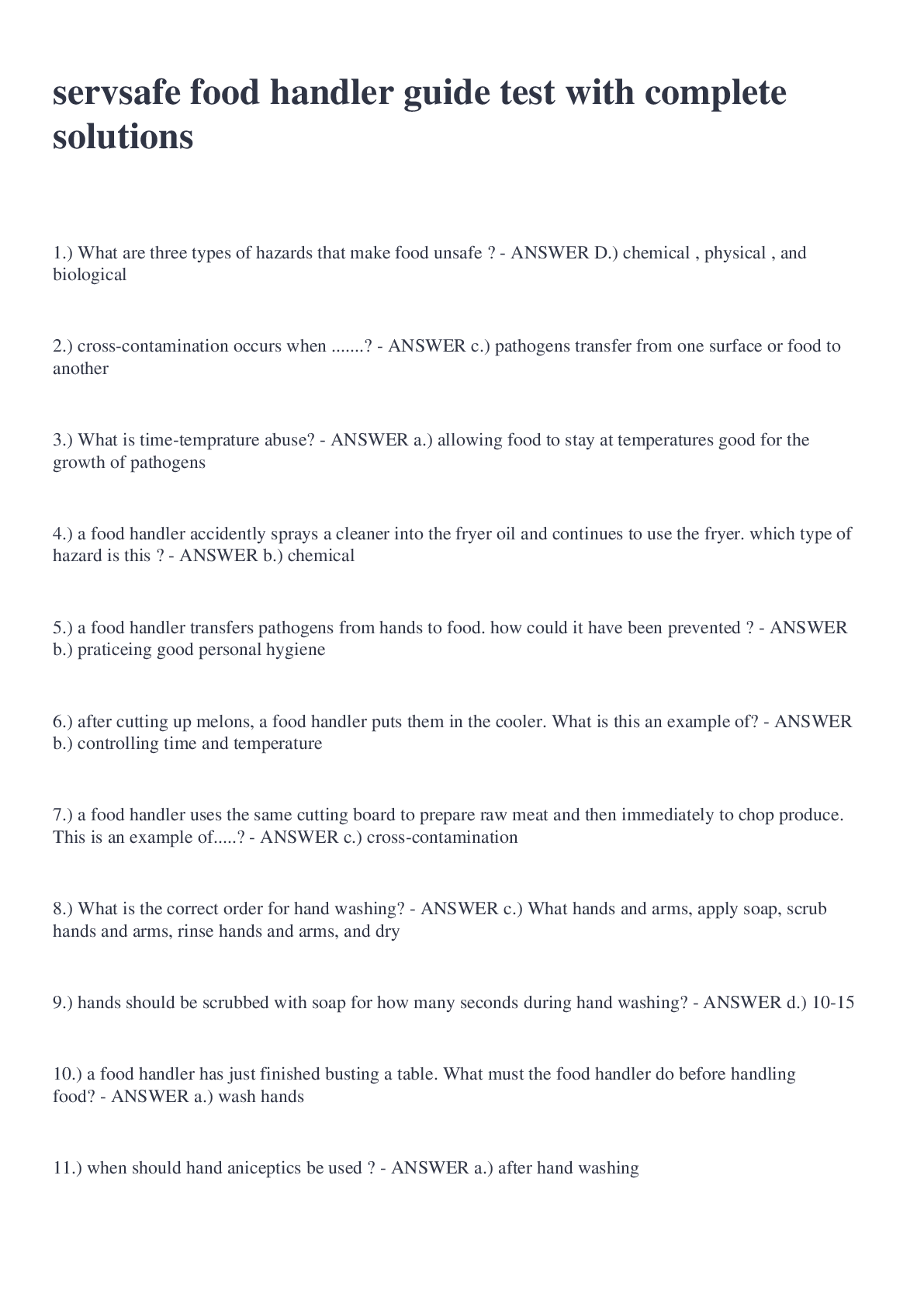


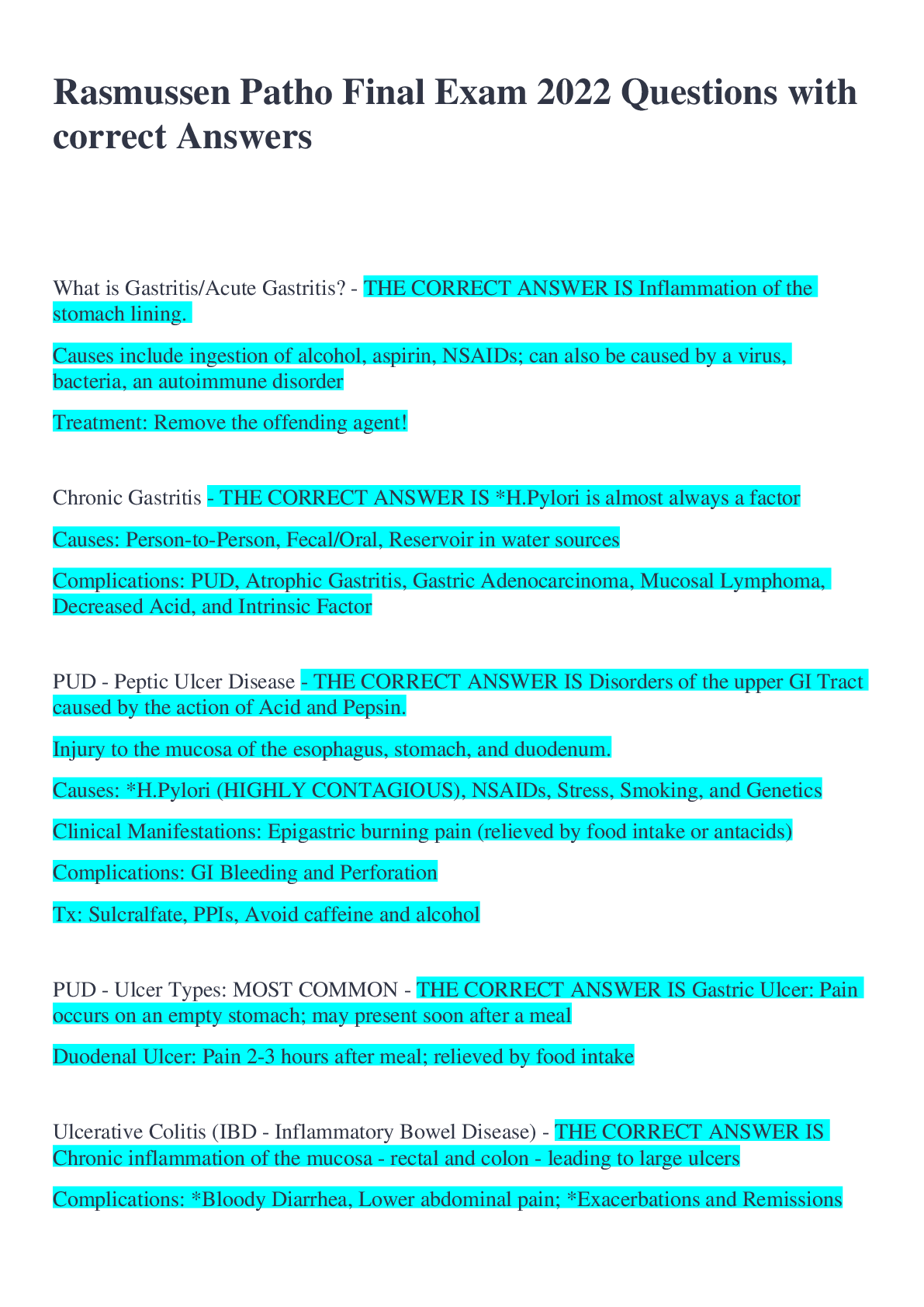

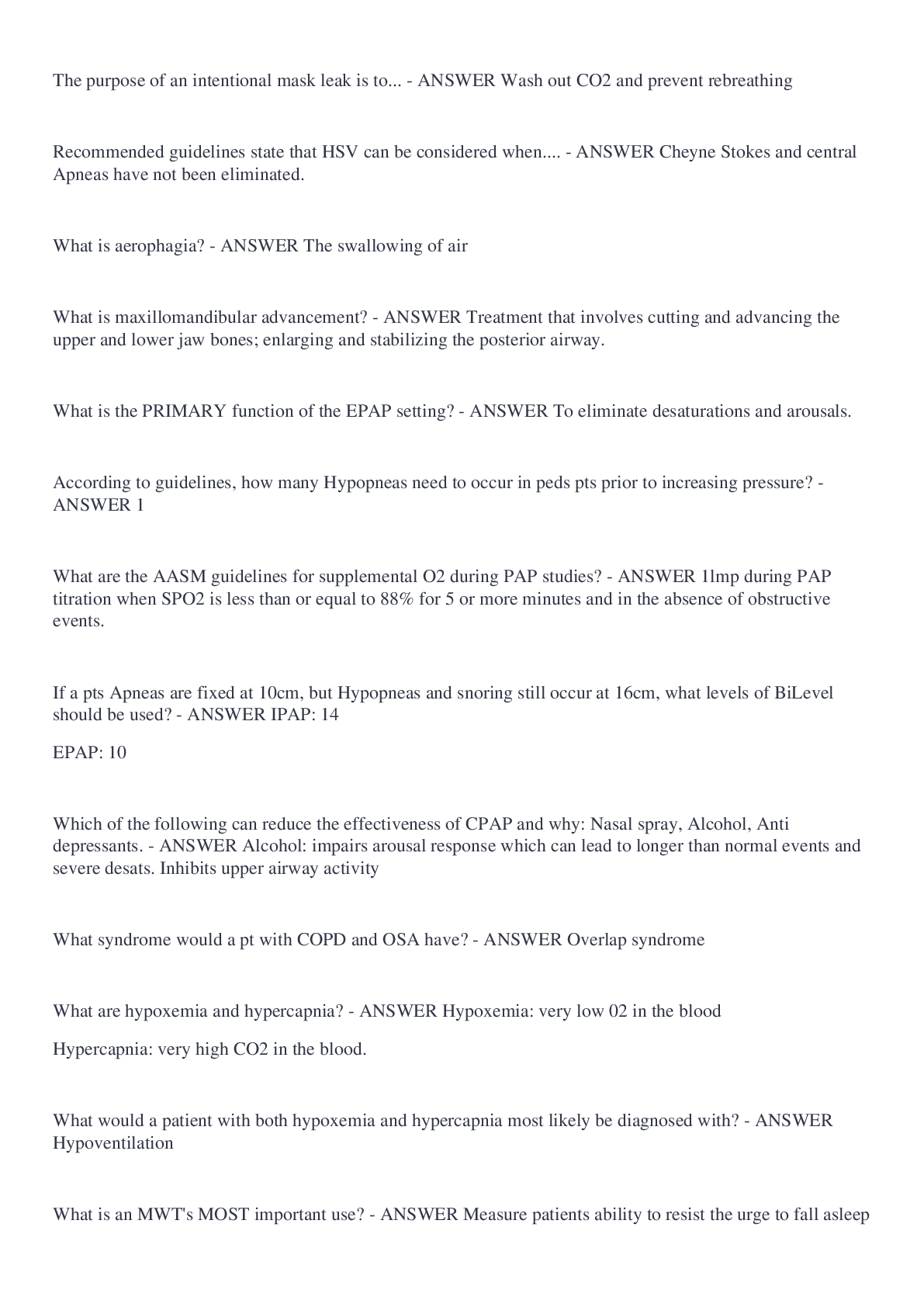



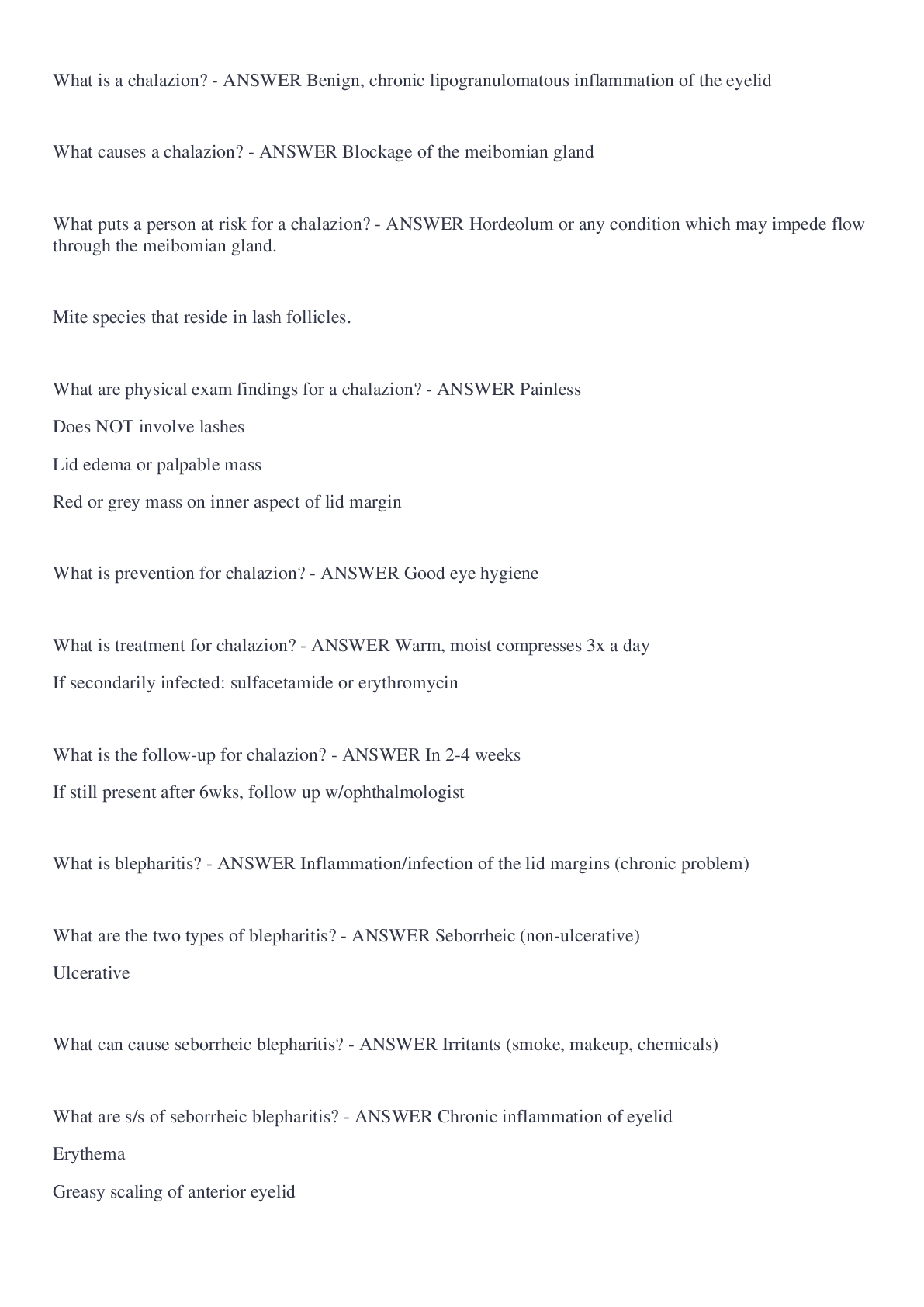


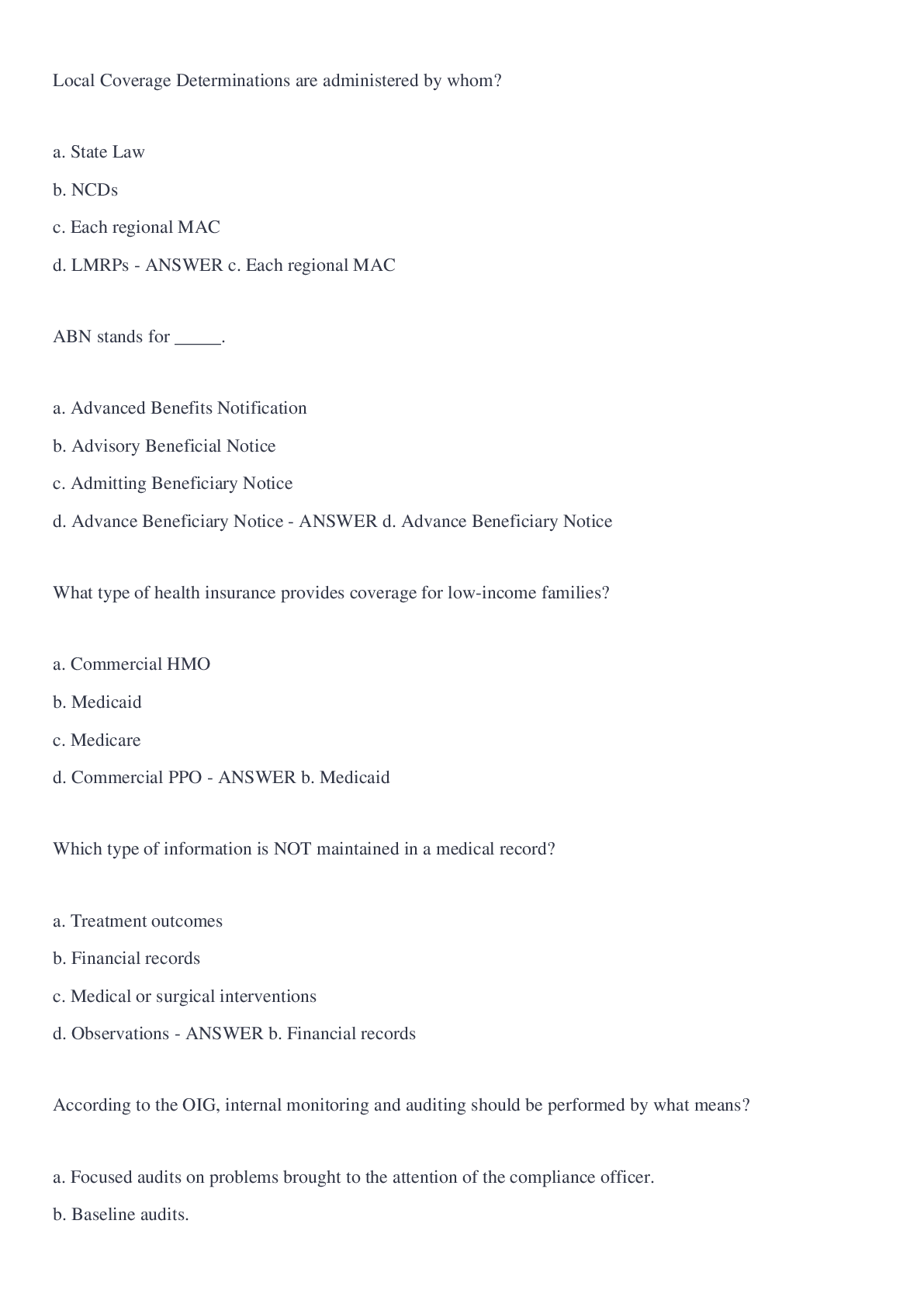
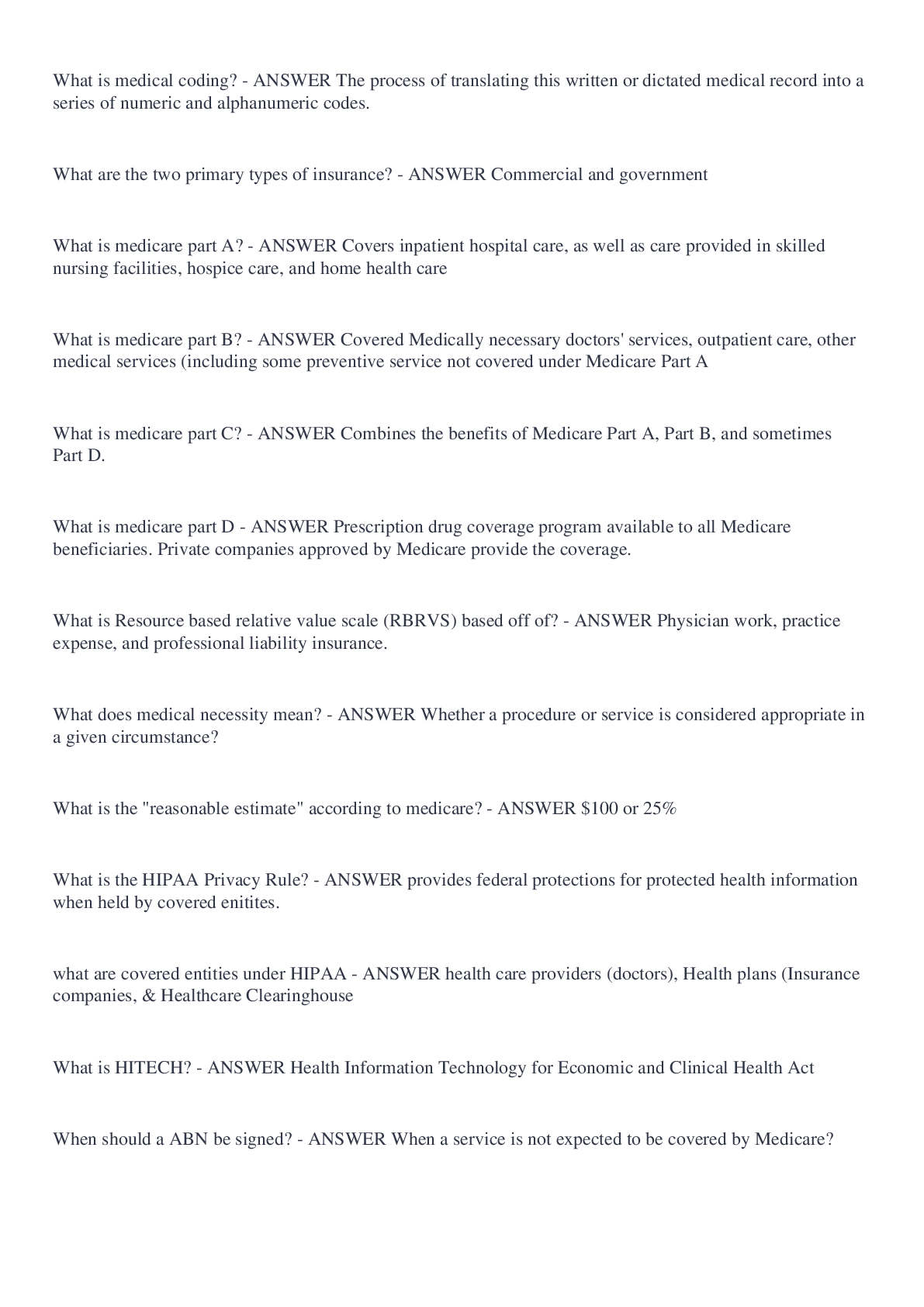
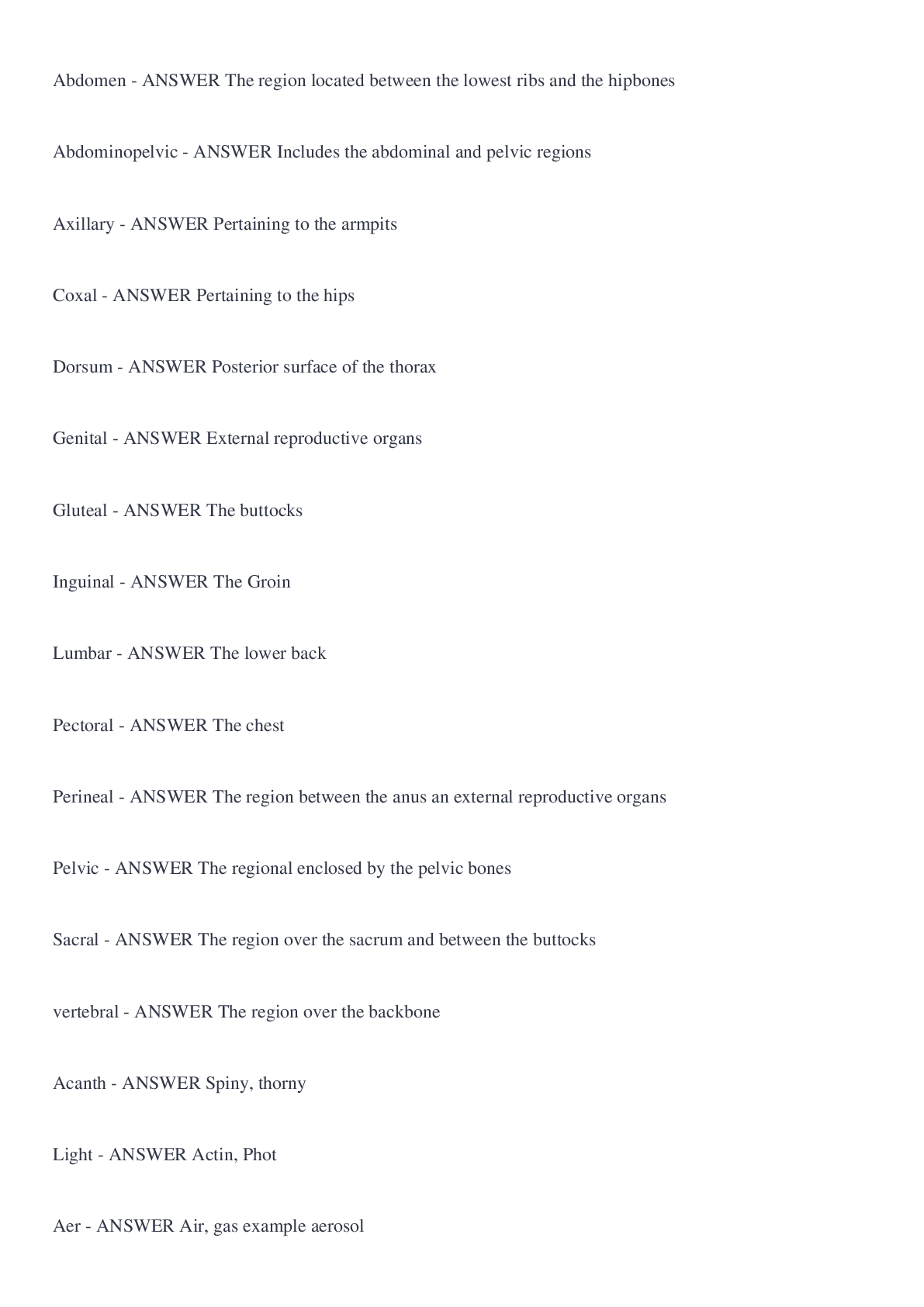

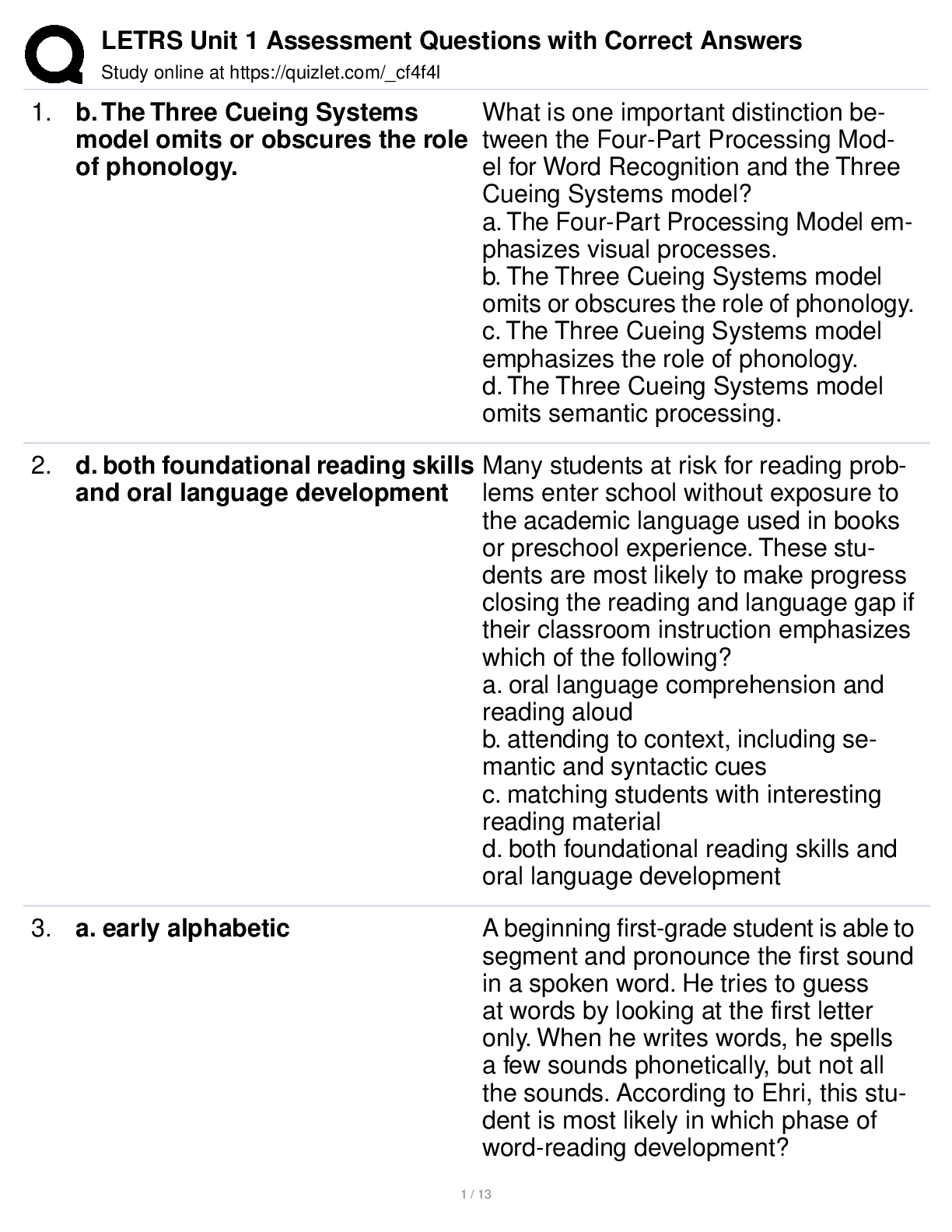


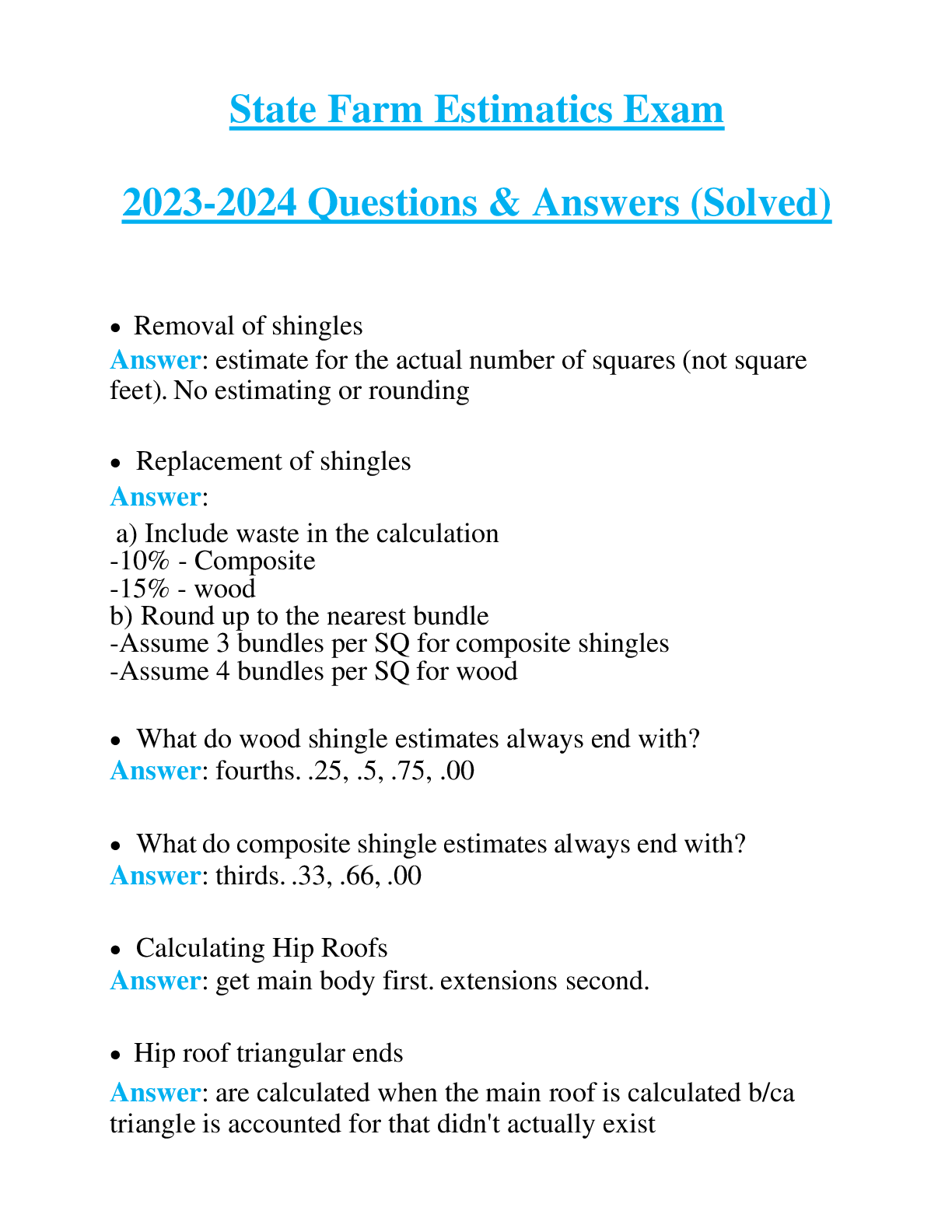
.png)



